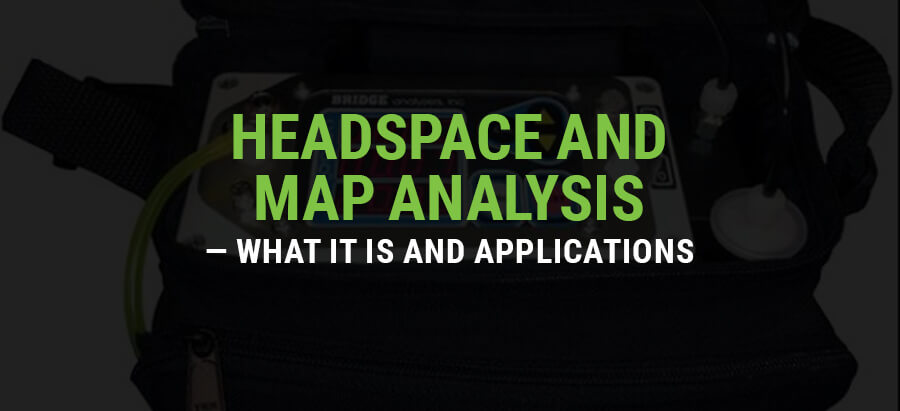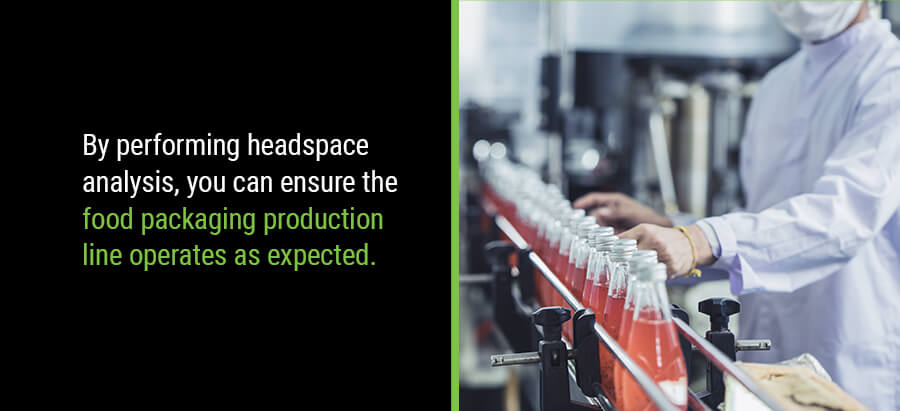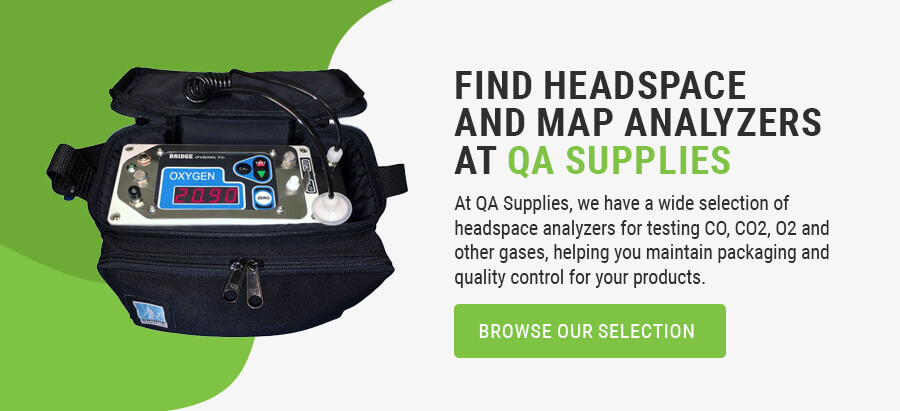Headspace and MAP Analysis — What It Is and Applications
Oct 24th 2022

Ensuring durable package design and preserving freshness and quality are integral components of food packaging. Headspace and MAP analysis plays a significant role in this process.
What is modified atmosphere packaging, and how does it work? Here's your complete guide to headspace analysis, modified atmosphere packaging gas composition and their applications.
What Is MAP Packaging and Headspace?
When you purchase a sealed product, there's a pocket of empty space in the package known as headspace. To preserve the product, prevent mold and bacteria growth, reduce oxidization rate and extend shelf life, this headspace typically contains a mixture of gases in differing proportions from the outside natural atmosphere. This process is known as modified atmosphere packaging or MAP.
Headspace analysis is a technical test that measures the amount of gas in the food packaging. Headspace analyzers, also called food packaging analyzers or MAP analyzers, feature built-in pumps that withdraw gas samples from packaged foods via a small syringe or probe.
From there, the gas is passed to sensors within the analyzer. The voltage changes based on sensor output and gas concentration. The headspace analyzer determines this gas concentration using curve-fitting algorithms.
Why Is It Necessary?

By performing headspace analysis, you can ensure the food packaging production line operates as expected. Furthermore, you can ensure the packaging isn't compromised with poor adhesion, pinholes or similar defects.
However, the composition and volume of gases can be integral in MAP applications. Understanding the MAP requirements for different food items is essential for designing and selecting packaging materials. You should also consider factors affecting MAP, which we'll discuss later.
What Gases Are Measured?
The gases typically used to create headspace include nitrogen (N2), carbon dioxide (CO2), oxygen (O2) and carbon monoxide (CO). The types of gases and ratios vary depending on the food and packaging type. Here are some examples of packaged foods and their typical MAP gas compositions:
- Fresh produce: Various physiological processes, such as respiration, occur in fresh produce since fruits and vegetables are alive. To lower respiration rates, microbial action and ethylene, there are usually higher levels of CO2 and lower levels of O2 in these packages than in the atmosphere. This also helps maintain color and aroma while preventing spoilage and fermentation.
- Meat: With MAP meat packaging, some oxygen is required to preserve the red color in meat. However, too much oxygen may lead to degradative oxidation and brown coloration. CO is added to pork for color stability, while CO2, CO and N2 maintain the color of beef and prevent microbial growth.
- Seafood: For various types of fish like catfish, herring, cod, salmon and swordfish, low O2 levels and high CO2 levels are used to control microbes.
What Impacts MAP?
These are some factors affecting headspace and MAP:
- Packaging material: The packaging material's permeability is the main factor affecting MAP and headspace. When O2 levels within the headspace drop, atmospheric O2 will likely diffuse into the package.
- Gas solubility: Gases mix and dissolve into packaged products, causing a loss in volume.
- Respiration rate: Fresh produce continuously respires since it's still alive. This respiration rate largely depends on the amount of O2. CO2 concentration rises as a result of respiration, generating warmth.
- External temperature: Temperature impacts the respiration rate of fresh produce, food quality and microbe growth. A lower temperature and steady gas concentration are ideal, especially for respiring products. High or fluctuating temperatures may cause anaerobic respiration, producing ethanol and diminishing flavor.
- Relative humidity: Moisture loss can result from low relative humidity or fluctuations. Water vapor cannot escape from the package, creating fog and condensation. If the temperature drops below the dew point, water vapor can liquify and encourage microbial growth.
- Light: Products react to light differently depending on the type of food, packaging material and light quality. In light-saturated environments, for instance, leafy vegetables photosynthesize, causing further complications. They're best stored in dark conditions with high CO2 levels. However, monitoring them carefully is crucial since low O2 and high CO2 can cause anaerobic respiration. Additionally, ham and beef can be negatively affected by light due to lipid photooxidation.
- Transport time: To determine headspace and MAP volume, consider transport distance to compensate for gas loss through permeable packaging and dissolution. There must be sufficient gas so the package doesn't deflate and compromise the food.
Applications of MAP and Headspace Analysis
MAP has significantly improved the packaging, safety and quality of food products, making it suitable for a range of industry- and research-related applications. Some examples include:
- Food quality: Extensive research is helping identify microbial activity in fresh and fresh-cut foods in different MAP conditions, ensuring optimal freshness and food quality.
- MAP recommendations: Research to determine effective MAP atmospheric conditions and package design explores various combinations of gases, relative humidity, temperature and storage length. This allows those who work in the food and packaging industries to make informed MAP recommendations for the safest practices.
- Packaging and quality control: Because headspace and MAP analysis helps ensure safe and functional food packaging, they're essential for quality control during storage and transport.
- Treatments: Creating ideal MAP conditions within the headspace affects more than packaging. It also provides applications in post-harvest pre-treatments. Heat treatment is a common technique to reduce microbial infection, respiration rates and chilling damage.
Pros and Cons
To recap, let's look at the overall pros of MAP and headspace analyzers:
- Gas detection: Headspace analyzers are incredibly helpful for detecting gases like CO2, O2 and CO.
- Preserves products: MAP helps extend the shelf life of food products by maintaining freshness and preventing the growth of harmful bacteria.
- Many uses: Headspace analyzers can test a wide variety of packaged products. Foods like produce, cheese, meat, cereal and coffee all employ MAP.
Now, here are some of their drawbacks:
- Relatively expensive: Headspace analyzers can cost thousands of dollars depending on the brand and model you choose. However, you may find its range of applications well worth the price tag.
- Destructive testing: Headspace analyzers use a destructive form of testing, as you'll need to puncture the food packet to sample the gas.
- High precision and frequent care: Headspace analyzers require periodic calibration to ensure an accurate reading. When testing a food or liquid, you'll also need to ensure it doesn't get sucked into the needle and tubing.
Find Headspace and MAP Analyzers at QA Supplies
When it comes to MAP food processing and headspace analysis, having the proper equipment is essential. At QA Supplies, we have a wide selection of headspace analyzers for testing CO, CO2, O2 and other gases, helping you maintain packaging and quality control for your products. Feel free to reach out to us with any questions about our headspace analyzers.


